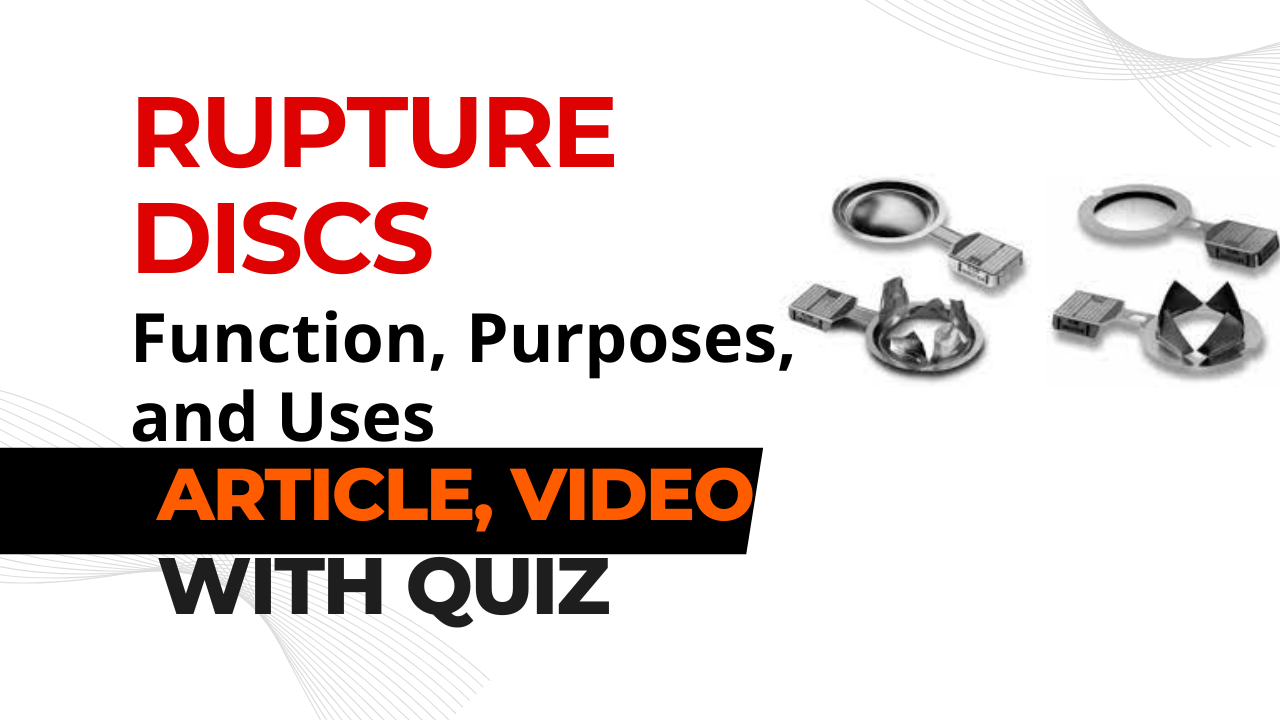Rupture disc, Pressure vessels and systems are integral components of numerous industries, from chemical manufacturing to oil and gas production. Ensuring the safety and reliability of these systems is paramount, and one crucial device that plays a pivotal role in this regard is the rupture disc. In this comprehensive guide, we’ll delve into the function, purposes, and various applications of rupture discs.
Table of Contents
Don’t miss the Complete Course on Piping Engineering: Check Now
By EPCLand.com
Understanding Rupture Discs: A Critical Safety Component
Rupture discs, also known as burst discs or pressure relief discs, are non-reclosing pressure relief devices. They are designed to relieve excess pressure in a vessel or system by rupturing at a predetermined pressure level. This rupture allows the pressurized fluid or gas to escape, preventing catastrophic failures and ensuring the safety of equipment, personnel, and the environment.
How Rupture Discs Differ from Safety Valves
While both rupture discs and safety valves serve the purpose of pressure relief, they have distinct differences. Safety valves are designed to open and reclose once pressure drops to a safe level, providing continuous pressure relief. On the other hand, rupture discs rupture only once and need to be replaced after each activation. They offer instantaneous, non-reclosing protection, making them suitable for scenarios where rapid pressure relief is critical.
Function of Rupture Discs: How They Work
Rupture discs operate based on the principle of structural integrity and material properties. They are composed of thin metallic or composite materials that are engineered to rupture at a specific pressure threshold. When the pressure within the vessel exceeds this threshold, the disc ruptures along predetermined lines, creating an opening for the pressurized medium to be released.
Types of Rupture Discs
- Reverse-acting Rupture Discs: These discs have a domed shape and are designed to rupture inwards when subjected to excessive pressure. They are suitable for applications where containment of the released material is crucial.
- Forward-acting Rupture Discs: These discs rupture outwards when pressure exceeds the predetermined limit. They are commonly used in applications where the released material can be safely directed away from sensitive equipment or personnel.
Purposes and Benefits of Rupture Discs
Rupture discs serve several vital purposes within industrial systems, contributing to safety, operational efficiency, and environmental protection.
1. Overpressure Protection
The primary purpose of rupture discs is to protect pressure vessels and systems from overpressure events. By relieving excess pressure, rupture discs prevent the potential for catastrophic failures, explosions, and subsequent damage.
2. Process Integrity
Rupture discs help maintain the integrity of industrial processes by preventing pressure-related disruptions. In scenarios where precise pressure control is essential, rupture discs act as the last line of defense to ensure the process operates within safe limits.
3. Environmental Safety
In industries handling hazardous or toxic materials, rupture discs play a crucial role in preventing releases that could harm the environment. Their instantaneous activation prevents uncontrolled emissions in case of pressure spikes.
4. Emergency Pressure Relief
During emergency situations, rupture discs provide rapid pressure relief, minimizing the risk of equipment damage and allowing operators to regain control of the system.
Applications of Rupture Discs Across Industries
Rupture discs find widespread applications in various industries due to their effectiveness in pressure management and safety assurance.
1. Chemical Manufacturing
Chemical processing plants use rupture discs to protect vessels and equipment from pressure fluctuations, ensuring the safety of both personnel and assets.
2. Oil and Gas Industry
In the oil and gas sector, rupture discs are employed in wellheads, pipelines, and storage tanks to prevent overpressure events that could lead to oil spills or explosions.
3. Pharmaceutical Production
The pharmaceutical industry relies on rupture discs to maintain sterile environments within vessels and reactors, safeguarding the quality of the products.
4. Food and Beverage Processing
Food and beverage manufacturers use rupture discs to prevent contamination risks by relieving excess pressure in tanks and vessels used for processing and storage.
5. Power Generation
Rupture discs play a critical role in power plants, protecting boilers, steam generators, and other systems from overpressure that could compromise their efficiency and safety.
FAQs About Rupture Discs
Q1: Can rupture discs be reused after activation? A1: No, rupture discs are non-reclosing devices and must be replaced after activation.
Q2: What materials are rupture discs made from? A2: Rupture discs are often made from materials like stainless steel, nickel alloys, or composite materials to suit different applications.
Q3: How do I determine the appropriate burst pressure for a rupture disc? A3: The appropriate burst pressure is determined by considering the system’s operating pressure and potential pressure spikes.
Q4: Can rupture discs be integrated with safety valve systems? A4: Yes, rupture discs can be used as a backup to safety valves, providing an additional layer of protection.
Q5: How often should rupture discs be inspected and replaced? A5: Regular inspections are recommended to ensure the integrity of rupture discs. Replacement intervals depend on factors like operating conditions and industry regulations.
Conclusion: Enhancing Safety and Process Efficiency
Rupture discs are indispensable components in industries where pressure management is critical. Their ability to provide instantaneous pressure relief helps prevent catastrophic failures and ensures the safety of equipment, personnel, and the environment. By understanding the function, benefits, and applications of rupture discs, industries can make informed decisions to enhance safety and operational efficiency.
In conclusion, rupture discs are not only safeguards against potential disasters but also vital tools that contribute to the smooth and secure operation of various industrial processes. As technology continues to advance, rupture disc designs evolve, offering more specialized solutions to meet the unique demands of different industries.
Recommended courses (Published on EPCLand)
- Basics of Piping Engineering
- Piping Layout Engineering
- Piping Material Engineering
- Piping Stress Analysis
- Complete Course on Piping Engineering
- Material Requisitions
- Piping Material Specifications
- Valve Material Specifications
Don’t miss the published articles on following:
Related Video
Attempt Quiz
Question 1:
What is the primary function of a rupture disc?
Explanation: The primary function of a rupture disc is to provide pressure relief by bursting and releasing pressure from a system when the predetermined pressure threshold is exceeded.
Question 2:
What is a common purpose of using rupture discs in industrial processes?
Explanation: A common purpose of using rupture discs in industrial processes is to prevent accidental overpressure situations that could lead to equipment failure or safety hazards.
Question 3:
Which industry sector often utilizes rupture discs for pressure protection?
Explanation: The aerospace industry often utilizes rupture discs for pressure protection in various components of aircraft and spacecraft systems.
Question 4:
What material is commonly used to manufacture rupture discs for compatibility with corrosive fluids?
Explanation: Metal alloys, such as stainless steel or nickel alloys, are commonly used to manufacture rupture discs for compatibility with corrosive fluids and aggressive process environments.
Question 5:
Which statement best describes the installation of a rupture disc in a pressure vessel?
Explanation: Rupture discs are often installed in parallel with pressure relief valves to provide a secondary means of pressure relief and enhance system safety.



